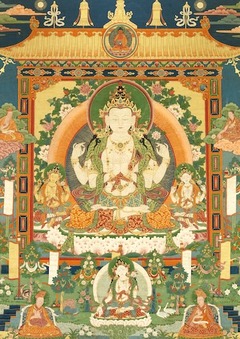Avalokiteśvara Dhāraṇī
༄༅། །འཕགས་པ་སྤྱན་རས་གཟིགས་དབང་ཕྱུག་གི་གཟུངས་ཞེས་བྱ་བ་བཞུགས་སོ། །
The Dhāraṇī of Noble Avalokiteśvara
from the Words of the Buddha
རྒྱ་གར་སྐད་དུ། ཨཱཪྻ་ཨ་བ་ལོ་ཀི་ཏེ་ཤྭ་ར་ནཱ་མ་དྷ་ར་ཎི།
In the language of India: āryāvalokiteśvara-nāma-dhāraṇī
བོད་སྐད་དུ། འཕགས་པ་སྤྱན་རས་གཟིགས་དབང་ཕྱུག་གི་གཟུངས་ཞེས་བྱ་བ།
In the language of Tibet: 'phags pa spyan ras gzigs dbang phyug gi gzungs zhes bya ba
In the English language: The Dhāraṇī of Noble Avalokiteśvara
འཕགས་པ་སྤྱན་རས་གཟིགས་ཐུགས་རྗེ་ཆེན་པོ་དང་ལྡན་པ་ལ་ཕྱག་འཚལ་ལོ། །
pakpa chenrezik tukjé chenpo dang denpa la chaktsal lo
Homage to noble Avalokiteśvara, the embodiment of great compassion!
འཕགས་པ་སྤྱན་རས་གཟིགས་དབང་ཕྱུག་བྱམས་པའི་ངང་ལས་སྙིང་རྗེའི་ཤུགས་ཀྱིས་བྱང་ཆུབ་ཀྱི་སེམས་རབ་ཏུ་བསྐྱེད་ནས་པདྨ་དང༌། ཉི་མ་དང༌། ཟླ་བའི་གདན་ལ་ཧྲཱིཿའི་འཕྲོ་འདུ་ལས་ཞལ་གཅིག་པ་ལ་ཕྱག་བཞི་པ། དང་པོ་གཉིས་ཐལ་མོ་སྦྱར་བ། གཡས་འོག་མ་ན་བགྲང་ཕྲེང་མུ་ཏིག་དཀར་པོ། གཡོན་འོག་མ་ན་པདྨ་དཀར་པོ་བསྣམས་པ། སྐུ་མདོག་དཀར་པོ་ཞབས་རྫོགས་པའི་སྐྱིལ་ཀྲུང་བཅས་པ། རིན་པོ་ཆེའི་རྒྱན་སྣ་ཚོགས་དང༌། རིན་པོ་ཆེའི་དབུ་རྒྱན་གྱིས་མཛེས་པ། མ་ལྷ་མོ་དྲུག་མ་དང༌། ཡབ་ནོར་བུ་རིན་པོ་ཆེས་བརྟེན་པ། བྱང་ཆུབ་སེམས་དཔའ་དང༌། སེམས་མ་རབ་ཏུ་མང་པོས་བསྐོར་ཏེ་འདི་སྐད་ཅེས་གསུངས་སོ། །
pakpa chenrezik wangchuk jampé ngang lé nyingjé shuk kyi changchub kyi sem rabtu kyé né pema dang nyima dang dawé den la hrih i trodu lé zhal chikpa la chakzhipa dangpo nyi talmo jarwa yé ok ma na drang treng mutik karpo yön ok ma na pema karpo nampa kudok karpo zhab dzokpé kyiltrung chepa rinpoche gyen natsok dang rinpoche ugyen gyi dzepa ma lhamo druk ma dang yab norbu rinpoche tenpa changchub sempa dang sem ma rabtu mangpö kor té diké ché sung so
Out of great love and the force of his boundless compassion, noble Avalokiteśvara generated bodhicitta, the heart of awakening. Seated upon a throne of lotus, sun, and moon he appeared through the emanation and reabsorption of light from the syllable hrīḥ. He manifests with one face and four arms: His first two hands are joined in the gesture of prayer. His lower right hand holds a white pearl mālā; his lower left, a white lotus. His body, white in colour, is seated in the full vajra posture, adorned with precious ornaments and a resplendent crown. At his side stand the mother Ṣaḍakṣarī and the father Maṇidhara.1 Around him gather countless male and female bodhisattvas, forming a vast retinue. Thus it was spoken:
རིགས་ཀྱི་བུའམ།
rik kyi bu am
O sons and daughters of noble family!
རིགས་ཀྱི་བུ་མོས་སྔགས་འདི་ལན་གཅིག་བརྗོད་དམ།
rik kyi bu mö ngak di len chik jö dam
Whether you recite my mantra but once,
དྲན་ཞིང་ཡིད་ལ་བྱས་སམ།
dren zhing yi la jé sam
Whether you hold it in your heart with steady recollection,
བྲིས་ནས་ལུས་ལ་བཅངས་སམ།
dri né lü la chang sam
Or write it down and carry it upon your body—
མོས་ཤིང་གུས་པར་བྱས་ན།
mö shing güpar jé na
If done with faith and devotion,
མཚམས་མེད་པ་ལྔ་དང༌།
tsammepa nga dang
You will purify the five gravest misdeeds2
དེ་དང་ཉེ་བའི་སྡིག་པའི་ལས་ཐམས་ཅད་བྱང་ཞིང༌།
dé dang nyewé dikpé lé tamché jang zhing
And the negative actions that are almost as grave.3
ངན་སོང་གསུམ་དང༌།
ngensong sum dang
You will be freed from the three lower realms
མི་ཁོམ་པ་བརྒྱད་དང༌།
mikhompa gyé dang
And the eight situations that are inopportune for Dharma practice.4
སྡུག་བསྔལ་དང་བཅས་པར་མི་སྐྱེའོ། །
dukngal dang chepar mi kyé o
You will never again be born into suffering.
མི་དང༌། མི་མ་ཡིན་པ་དང༌། གཅན་གཟན་གྱི་འཇིགས་པ་ཐམས་ཅད་ལས་གྲོལ་བར་འགྱུར་རོ། །
mi dang mi mayinpa dang chenzen gyi jikpa tamché lé drolwar gyur ro
All harm from humans, non-humans, and wild beasts will be pacified.
ནད་དང་གདོན་ཐམས་ཅད་ལས་ཐར་བར་འགྱུར་རོ། །
né dang dön tamché lé tarwar gyur ro
You will be released from all illnesses and obstructing influences.
ཨོཾ་མ་ནི་པདྨེ་ཧཱུྃ།
om mani pedmé hung
oṃ maṇi padme hūṃ
ཞེས་བརྗོད་པས་འཕགས་པ་སྤྱན་རས་གཟིགས་ཀྱི་ཞལ་མཐོང་བར་འགྱུར་ཞིང༌། ཚེ་འཕོས་ནས་ཀྱང་བདེ་བ་ཅན་དུ་སྐྱེ་སྟེ། འདི་ལ་ཐེ་ཚོམ་མམ། སོམ་ཉིའམ། ཡིད་གཉིས་མ་ཟ་ཞིག །
zhé jöpé pakpa chenrezik kyi zhaltongwar gyur zhing tsé pö né kyang dewachen du kyé té di la tetsom mam somnyi am yinyi ma za zhik
By reciting this sacred mantra, you shall behold the face of noble Avalokiteśvara, and at the end of this life, you will be reborn in the pure-land of Sukhāvatī. Have no hesitation, uncertainty, or doubt about this truth.
འཕགས་པ་སྤྱན་རས་གཟིགས་དབང་ཕྱུག་གི་གཟུངས་རྫོགས་སོ།། །།
pakpa chenrezik wangchuk gi zung dzok so
This concludes the Dhāraṇī of Noble Avalokiteśvara.
| Samye Translations (trans. Stefan Mang), 2025.
Tibetan Source:
Toh 696. 'phags pa spyan ras gzigs dbang phyug gi gzungs. sde dge bka’ ‘gyur. Vol. 93 (rgyud, tsa): 147b3–148a2.
Version: 1.0-20250507
- ↑ In his four-armed form (Skt. caturbhuja; Tib. phyag bzhi pa), Avalokiteśvara is often flanked by Maṇidhara (Tib. nor bu rin po che / nor bu ’dzin pa) on his right and Ṣaḍakṣarī (Tib. lha mo drug ma) on his left. According to certain source texts, these two figures are sometimes described as Avalokiteśvara’s son and daughter, respectively. Ṣaḍakṣarī is also regarded as the personification of the six-syllable mantra oṃ maṇi padme hūṃ.
- ↑ Also known as the five inexpiable acts or the five acts with immediate retribution, these are (1) killing one’s mother, (2) killing one’s father, (3) killing an arhat, (4) drawing blood from a tathāgata, and (5) causing a schism in the saṅgha.
- ↑ The five actions that are almost as grave as the five crimes with immediate retribution are (1) damaging a stūpa/caitya, (2) killing a bodhisattva, (3) violating a female arhat, (4) killing someone training towards the supreme level, and (5) stealing from the saṅgha.
- ↑ Being born (1) in hell, (2) in preta realms, (3) in the animal realm, (4) amidst long-living gods, (5) in uncivilized lands, (6) with wrong views, (7) in a world where a buddha has not come, or (8) incapable of understanding.
